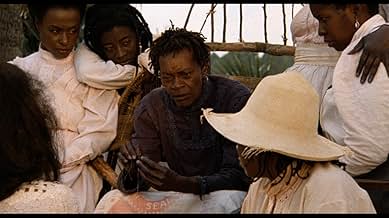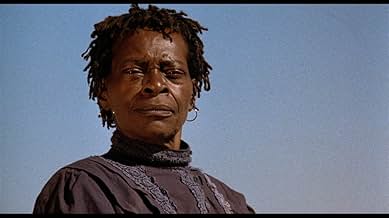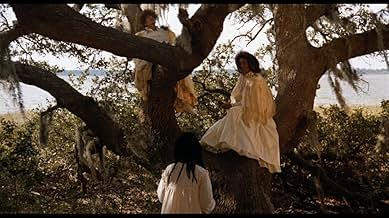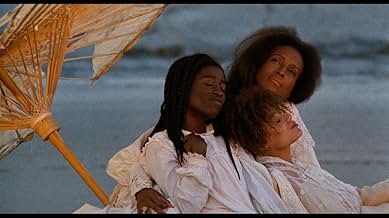IMDb रेटिंग
6.6/10
3.6 हज़ार
आपकी रेटिंग
अपनी भाषा में प्लॉट जोड़ेंA languid, impressionistic story of three generations of Gullah women living on the South Carolina Sea Islands in 1902.A languid, impressionistic story of three generations of Gullah women living on the South Carolina Sea Islands in 1902.A languid, impressionistic story of three generations of Gullah women living on the South Carolina Sea Islands in 1902.
- पुरस्कार
- 4 जीत और कुल 2 नामांकन
Barbara O
- Yellow Mary
- (as Barbara-O)
Tony King
- Newlywed Man
- (as Malik Farrakhan)
फ़ीचर्ड समीक्षाएं
Daughters of The Dust was produced by Geechee Girls and American Playhouse Company. The movie main focus is on the Peazant women. Nana Peazant is played by Cora Lee Day, and Eula, her granddaughter, is played by Alva Rogers who is pregnant and has been raped by a landowner. Nana's granddaughter, Yellow Mary, is played by Barbara-O who is returning, with her friend Trula, from the mainland and her life as a prostitute and wet nurse. Haggar, who has married into the family, is played by Kaycee Moore and wants nothing to do with the old traditions. Similarly, the Christian Viola, played by Cheryl Lynn Bruce, is returning from her life on the mainland.
Daughters of the Dust is a film written and directed by Julie Dash. It tells the story of a family of African-Americans who have lived for many years on a Southern offshore island, and of how they come together one day in 1902 to celebrate their ancestors before some of them leave for the North. The film is narrated by an unborn child, and ancestors already dead also seem to be as present as the living.
Julie Dash underwent many hardships in bringing the story to the silver screen. She had severe budget constraints, filmed in mosquito and insect infested areas, was delayed by Hurricane Hugo, sidetracked by sudden and violent sandstorms, and was forced to decide to either have a child or make the movie. In the end, she choose to give birth and nurture the story Daugthers of the Dust and the result is an unconventional masterpiece.
Initially, the response by white male critics was not favorable and they accused Dash of not adequately explaining the Gullah people, their culture, and their religious traditions. While attacking Dash, these critics failed to acknowledge many positive aspects of the film. The reasons behind this, according to Bell Hooks, is that "we've never been taught, most of us, in any history class that black people had different languages, had different religious practices, etc. So, to some extent, the film represents that challenge to a critic of any race" to review something they are not familiar with.
Because of these reviews and the fact that movie tells the story of African American women in an unconventional manner, it would seem to have slim commercial prospects. However, through word of mouth and some positive reviews it was able to generate a cult following. To date, the film has grossed 1.6 million from a budget of only 800,000.
The Newark Black Film Festival has chosen Daughters as the Film of The Century while the British Film Institute's Sight and Sound Magazine chose the soundtrack as one of the best in the past 25 years. It also received the Best Cinematography award at the Sundance Film Festival in 1991.
I believe the film hits the viewer on various levels. By placing the story in the early 1900's, Dash is able to show us a turbulent time for African-Americans and address many issues such as migration, lynching, and the changing African-American culture. Dash also shows and teaches us about Ibo culture and it's importance in the lives of those inhabiting the Sea Coast Islands, not just the African-Americans sharing the Gullah culture, but also the Native Americans, Muslims, and Christians.
Daughters of the Dust is a film written and directed by Julie Dash. It tells the story of a family of African-Americans who have lived for many years on a Southern offshore island, and of how they come together one day in 1902 to celebrate their ancestors before some of them leave for the North. The film is narrated by an unborn child, and ancestors already dead also seem to be as present as the living.
Julie Dash underwent many hardships in bringing the story to the silver screen. She had severe budget constraints, filmed in mosquito and insect infested areas, was delayed by Hurricane Hugo, sidetracked by sudden and violent sandstorms, and was forced to decide to either have a child or make the movie. In the end, she choose to give birth and nurture the story Daugthers of the Dust and the result is an unconventional masterpiece.
Initially, the response by white male critics was not favorable and they accused Dash of not adequately explaining the Gullah people, their culture, and their religious traditions. While attacking Dash, these critics failed to acknowledge many positive aspects of the film. The reasons behind this, according to Bell Hooks, is that "we've never been taught, most of us, in any history class that black people had different languages, had different religious practices, etc. So, to some extent, the film represents that challenge to a critic of any race" to review something they are not familiar with.
Because of these reviews and the fact that movie tells the story of African American women in an unconventional manner, it would seem to have slim commercial prospects. However, through word of mouth and some positive reviews it was able to generate a cult following. To date, the film has grossed 1.6 million from a budget of only 800,000.
The Newark Black Film Festival has chosen Daughters as the Film of The Century while the British Film Institute's Sight and Sound Magazine chose the soundtrack as one of the best in the past 25 years. It also received the Best Cinematography award at the Sundance Film Festival in 1991.
I believe the film hits the viewer on various levels. By placing the story in the early 1900's, Dash is able to show us a turbulent time for African-Americans and address many issues such as migration, lynching, and the changing African-American culture. Dash also shows and teaches us about Ibo culture and it's importance in the lives of those inhabiting the Sea Coast Islands, not just the African-Americans sharing the Gullah culture, but also the Native Americans, Muslims, and Christians.
I saw this film for a film class at UF. We have seen some slow and some fast-paced films. This is by far the slowest we have seen and is the most boring piece of cinema I have ever seen.
Now, it's not ALL bad. The movie has some cultural significance and was obviously researched before filming. The shot selection was very good, colors vibrant, and you could feel the actors' emotions.
But the story... was slow. There's a load of characters and I couldn't figure out who was related to who and what all had happened with the pregnant woman. The movie was like the opening title-card sequence to Black Hawk Down stretched out to 2 hours in length. There's parts with loads of music and no dialogue and vice versa. The movie seemed to reach an ending 5 times before it finally did. The writer-director clearly had no clue as to what pacing was.
The story was basically about some African-Americans at the turn of the century who boat down to their family on the shores of some island that is separated on one side by a river and the ocean on the other. They want a better life and are split about whether the island or the mainland is the better spot for it. It takes them two agonizing (to us) hours to decide.
Long [very long] story short: half the class walked out in the first hour. And I was jealous of those who did when I reached the end of the film. 2/10
Now, it's not ALL bad. The movie has some cultural significance and was obviously researched before filming. The shot selection was very good, colors vibrant, and you could feel the actors' emotions.
But the story... was slow. There's a load of characters and I couldn't figure out who was related to who and what all had happened with the pregnant woman. The movie was like the opening title-card sequence to Black Hawk Down stretched out to 2 hours in length. There's parts with loads of music and no dialogue and vice versa. The movie seemed to reach an ending 5 times before it finally did. The writer-director clearly had no clue as to what pacing was.
The story was basically about some African-Americans at the turn of the century who boat down to their family on the shores of some island that is separated on one side by a river and the ocean on the other. They want a better life and are split about whether the island or the mainland is the better spot for it. It takes them two agonizing (to us) hours to decide.
Long [very long] story short: half the class walked out in the first hour. And I was jealous of those who did when I reached the end of the film. 2/10
A Feast For the Eyes, Ears, And Heart, March 26, 2001 Reviewer: Angela Jefferson (see more about me) from Memphis, Tn USA In the opening of her film, Daughters of the Dust, Julie Dash alerts the viewer that this is no ordinary African American story. Conversely, this is an American history lesson with African origins. A small informative note at the start of the film puts the entire movie in context. Without this explanatory foreword, many viewers would probably find the film hard to understand. Though the movie tells the story of the Peazant family's migration from the sea islands of the South, the story also gives a panoramic view of the Gullah culture at-large. Because the islands are isolated from the mainland states, the Gullah retain a distinct African ethnicity and culture. Ironically, the Peazants want to rid themselves of the old ways and heritage, thus beginning an exodus from the islands to the mainland. Taking place in 1902, just fifty years after the end of slavery, Daughter of the Dust explores the Peazant's struggle for survival and escape from poverty. The movie opens on the eve of the family's great migration to the mainland. A family celebration and farewell-of-sorts take place on the beach. The Peazants even hire a photographer to document this momentous occasion. As the movie progresses, the complexity of the family's departure from the island emerges. Difference and changing values mire the pending migration with conflict and strife. As the family prepares to leave, in search of a new life and better future, the film reveals the richness of the Gullah heritage. Narrations of "the unborn child" of Eli and Eula Peazant offer glimpses into problems the family has faced since their existence on the island. As explained by matriarch Nana Peazant, the Gullah are like "two people in one body." Though most Peazants were born in the Americas, their African heritage is forever evident. The internal conflicts of this duality haunt the family as they become ensnarled in battle, only to war against themselves. Through old African customs and rituals, such as glass bottle trees, salt water baths, and herb potions, Nana wants to ensure that the family stays together. Moreover, Nana, "the last of the old," has chosen to stay on the island. She celebrates everything that makes her who she is: the ugly and the good. She knows slavery and she knows freedom. Her life revolves around the continuation and strengthening of the Peazant family. Her rituals are often unappreciated and looked upon with scorn by other family members. Some family members are unwilling to grasp Nana's teachings and wisdom. They want to escape the island, to run away from the Gullah way of life. However, they cannot run from themselves. Just as Nana proclaims, they will always live a double life, no matter where they go. The trip to the mainland certainly cannot rid their indigo stained hands of its blue-blackish tint. Nor can the northern journey erase the memories of whom or what they are leaving. Unbeknownst to the younger Peazants, the duality, the recollections and remembrances, and the old way and traditions are gifts from their ancestors. Sadly, few are able to accept these gifts or comprehend their importance. Through authentic Gullah dialect, vivid imagery and colorful characters, Dash reveals the uniqueness of the Gullah people. A cousin, Yellow Mary, returns from Cuba to the island, facing the scorn of her people because she is a "ruint 'oman." Haggar, a bitter woman who wants nothing to do with the old Gullah ways, does not realize that she cannot rid herself of whom she is. For example, she despises the "old Africans," yet retains their ways in her speech and use of African colloquialisms. Another cousin, Viola is full of Christian religious fervor and against the heathen practices and nature-worshiping traditions of her people. Eula, who gives a heart- wrenching soliloquy at the end of the movie, bears the burden of pregnancy and rape by a white man. Eli, Eula's husband, represents the strength and future of the Peazant clan. Besides being adept at character development, Julie Dash effectively educates the viewer about African-American history. Tales of flying Africans, water-walking Ibo, Islamic religion, and slave trading are skillfully woven in small snatches throughout the film. We also see connections between African-Americans and Native Americans. The lessons learned from this film are too numerous. One must see the film more than once to appreciate all the information presented. Daughters of the Dust awakens all the senses. The beautiful cinematography transports viewers to a surreal place and time, creating a visual paradise. Each scene makes its introduction with mesmerizing African music, which aptly fits each setting. As the Gullah women prepare food for the feast, one cannot help but imagine the taste and smell of gumbo, shrimp, and crab. This movie also arouses the heart. One can easily identify and empathize with the characters' passion and sincerity. Often, the characters relay sentiments and convictions so convincingly, that it is hard to believe that the players were acting. Understanding complete passages is often difficult because of the beautiful and authentic tonality of the language. Nonetheless, the use of standard English could not have conveyed Dash's message as successfully. We should appreciate this film for its originality and courage. Stories such as these are hardly ever told. Most films neglect the eclectic nature of the African American community, usually focusing on only aspects that are familiar to the masses. Here, Julie Dash reaches beyond the boundaries that are set for African-American films. Equally as important is her ability and willingness to validate the African-American experience. She eloquently and subtly deals with difficult subjects such as slavery, self-hatred, feminism, color prejudices, and rape. Dash does not throw one viewpoint in your face. Conversely, Dash gives the viewer a front row seat into the lives of a remarkable people. We are then left to draw conclusions for ourselves. One feels liberated, proud, and honored to be allowed a window into their lives. The movie is a celebration of the African-American diaspora. The images, language, and music of Daughters of the Dust will linger in the minds of its fortunate viewers forever.
Daughters in the Dust is one of those rare movies that truly makes you wonder long and hard about the possibilities of the film form. The film as pure narrative leaves much to be desired; yet it's is not concerned about telling the intricate and sentimental goings-on of one or two human beings; a single tale told in one moment in time. No, the film's scope is much wider and anthropological in scale, thus requires more than just a passing judgment on its entertainment value.
The film concerns itself with the Peazant family; proud members of Gullah creoles who originated from slaves traded along the remote islets of South Carolina and Georgia. Even before the Civil War generations of the Gullah people lived quietly as rice farmers on these islands and thanks in large part to regional isolation they were able to rebuild and retain much of the linguistic, cultural and religious heritage that had been wiped out by the slave trade. By 1901, the Peazants are mulling over the idea of relocating to the mainland.
The film has the narrative distinction of being told from the perspective of an unnamed and unborn member of the Peazants played by Kay-Lynn Warren. At only four, the young Warren peeks through the hole of her family's history only appearing twice herself as a sprite. We meet her pregnant mother Eula (Rogers), her aunts Haagar (Moore), Viola (Bruce) and Yellow Mary (Barbara-O) as well as Nana (Day) the matriarch of the family. Nana is old enough to remember the scourge of slavery and as a result is resonant to move to the mainland. Meanwhile Haagar is the strongest advocate for the move saying "If Nana wants to live and die on this island, then God bless her old soul." Two members of the clan have already moved away; Viola who moved to Philadelphia to become a ardent Christian; and Yellow Mary, who according to Viola is a "wasted woman".
Despite showcasing a family hungry for change and progress, the film gives proper reverence to the traditions of the Gullah people. The most respected people on the island are the elders who consist of Nana and Bilal Muhammad (Abdurrahman) the resident mullah. The spiritual ceremonies of the family relies on a mixture of Christianity, Islam and African animism that gives everything natural around them a lyrical quality. Yet underneath the pleasant depictions of sun-soaked beaches and marshy lowlands the internal conflict behind the eyes of the Peazants can't help but surface during communal gatherings. "We are two people in one body," says Nana as she defies the rest of the family who hope to travel north with their hopes and dreams.
If there is one glaring problem with Daughters of the Dust it's its expectations of the viewer. During production director Julie Dash wanted to keep the authenticity of the people intact and thus had actors speak only in the Gullah dialect and didn't consider subtitles. A minority of audience members may find this tact a mesmerizing exercise in linguistics. A feeling not unlike hearing the warm familiar sounds of your parents speaking while you were a toddler. From a purely anthropological perspective this was the best narrative choice one could hope for, allowing those with patience further rewards with repeated viewings. Unfortunately if you're not one of patience or a strong interest in anthropology or etymology you might find yourself distracted and looking for other stimuli.
There are many ways to read a movie of this nature. Most movies start and end with a graspable narrative, quick and easy explanations to plot details and an clear resolution. Daughters of the Dust doesn't let you off the hook with easy solutions. It instead asks serious questions. Questions that highlight the consequences of modernity's encroachment on tradition, cultural identity, cross-generational turmoil and diaspora. Furthermore the movie gives willing audiences a sense of belonging among the Gullah people; a warmth you seldom feel on the screen. It also does so in a very spirited and exquisite way featuring some of the most lyrical visual storytelling $800,000 can buy.
The film concerns itself with the Peazant family; proud members of Gullah creoles who originated from slaves traded along the remote islets of South Carolina and Georgia. Even before the Civil War generations of the Gullah people lived quietly as rice farmers on these islands and thanks in large part to regional isolation they were able to rebuild and retain much of the linguistic, cultural and religious heritage that had been wiped out by the slave trade. By 1901, the Peazants are mulling over the idea of relocating to the mainland.
The film has the narrative distinction of being told from the perspective of an unnamed and unborn member of the Peazants played by Kay-Lynn Warren. At only four, the young Warren peeks through the hole of her family's history only appearing twice herself as a sprite. We meet her pregnant mother Eula (Rogers), her aunts Haagar (Moore), Viola (Bruce) and Yellow Mary (Barbara-O) as well as Nana (Day) the matriarch of the family. Nana is old enough to remember the scourge of slavery and as a result is resonant to move to the mainland. Meanwhile Haagar is the strongest advocate for the move saying "If Nana wants to live and die on this island, then God bless her old soul." Two members of the clan have already moved away; Viola who moved to Philadelphia to become a ardent Christian; and Yellow Mary, who according to Viola is a "wasted woman".
Despite showcasing a family hungry for change and progress, the film gives proper reverence to the traditions of the Gullah people. The most respected people on the island are the elders who consist of Nana and Bilal Muhammad (Abdurrahman) the resident mullah. The spiritual ceremonies of the family relies on a mixture of Christianity, Islam and African animism that gives everything natural around them a lyrical quality. Yet underneath the pleasant depictions of sun-soaked beaches and marshy lowlands the internal conflict behind the eyes of the Peazants can't help but surface during communal gatherings. "We are two people in one body," says Nana as she defies the rest of the family who hope to travel north with their hopes and dreams.
If there is one glaring problem with Daughters of the Dust it's its expectations of the viewer. During production director Julie Dash wanted to keep the authenticity of the people intact and thus had actors speak only in the Gullah dialect and didn't consider subtitles. A minority of audience members may find this tact a mesmerizing exercise in linguistics. A feeling not unlike hearing the warm familiar sounds of your parents speaking while you were a toddler. From a purely anthropological perspective this was the best narrative choice one could hope for, allowing those with patience further rewards with repeated viewings. Unfortunately if you're not one of patience or a strong interest in anthropology or etymology you might find yourself distracted and looking for other stimuli.
There are many ways to read a movie of this nature. Most movies start and end with a graspable narrative, quick and easy explanations to plot details and an clear resolution. Daughters of the Dust doesn't let you off the hook with easy solutions. It instead asks serious questions. Questions that highlight the consequences of modernity's encroachment on tradition, cultural identity, cross-generational turmoil and diaspora. Furthermore the movie gives willing audiences a sense of belonging among the Gullah people; a warmth you seldom feel on the screen. It also does so in a very spirited and exquisite way featuring some of the most lyrical visual storytelling $800,000 can buy.
It's tough to sort my feelings on Daughters of the Dust. The film is built around a compelling and often forgotten segment of black history that maintains social resonance beyond its time and place; director Julie Dash deserves credit for capturing the emotion and pain of cultural transformation, and there are lovely images throughout. But Daughters of the Dust makes very little effort to engage the audience: it's difficult to maintain a sense of each character's individual goals, and the film often sacrifices narrative momentum for visual poetry. Unfortunately, I'm left with a film that interests me more in theory than in practice. -TK 9/30/10
क्या आपको पता है
- ट्रिवियाSelected to the Library of Congress National Registry of Film in 2004.
- भाव
[first lines]
Nana Peazant: I am the first and the last. I am the honored one and the scorned one. I am the whore and the holy one. I am the wife and the virgin. I am the barren one and many are my daughters. I am the silence that you can not understand. I am the utterance of my name.
टॉप पसंद
रेटिंग देने के लिए साइन-इन करें और वैयक्तिकृत सुझावों के लिए वॉचलिस्ट करें
- How long is Daughters of the Dust?Alexa द्वारा संचालित
विवरण
बॉक्स ऑफ़िस
- US और कनाडा में सकल
- $16,83,422
- US और कनाडा में पहले सप्ताह में कुल कमाई
- $10,842
- 20 नव॰ 2016
- दुनिया भर में सकल
- $16,89,776
- चलने की अवधि
- 1 घं 53 मि(113 min)
- रंग
- पक्ष अनुपात
- 1.85 : 1
इस पेज में योगदान दें
किसी बदलाव का सुझाव दें या अनुपलब्ध कॉन्टेंट जोड़ें


















